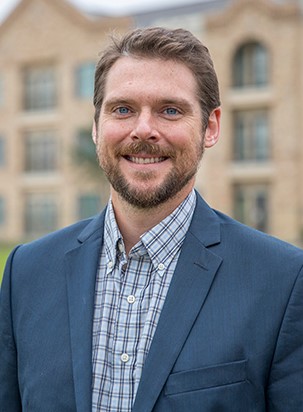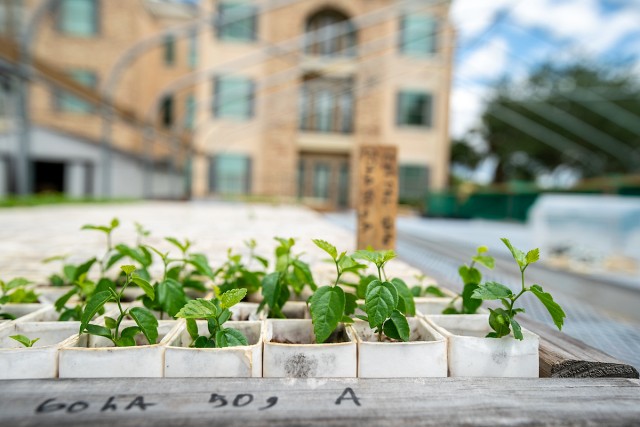UTRGV growing 100K tree seedlings to help local wildlife
Wednesday, July 15, 2020
Community, Research
By Maria Elena Hernandez
RIO GRANDE VALLEY, TEXAS – Despite financial support and an abundance of available land, reforestation efforts in the Rio Grande Valley face a key obstacle.
“There just aren't enough trees,” said Dr. Christopher Gabler, an assistant professor in the UTRGV School of Earth, Environmental and Marine Sciences.
The trees, specifically the kinds native to Tamaulipan thornscrub forests, serve as habitats for local wildlife. And that wildlife brings hundreds of millions of dollars into the Valley though ecotourism and jobs.
“We're recognizing the importance of these trees and of these ecosystems and the services they provide us, which are not just ocelot habitat or bird-foraging areas,” Gabler said. “They also fix carbon and they help us regulate climate.”

To aid in reforestation, the university is growing 100,000 seedlings native to Tamaulipan thornscrub, which will be planted in the fall in areas like La Sal Del Rey National Wildlife Refuge in central Hidalgo County.
One of the reasons the native plants aren't commercially available is because information is so limited about the more than 70 species found in thornscrub forests, Gabler said.
“There's a significant amount of local expertise on this. That said, it's very limited compared to how much we know about other species," he said. “Very few of them are well studied enough that somebody could just go look up how to grow them.”
The seedlings are being grown on the UTRGV Brownsville Campus.
“Of the 16 species that we're growing this year, two of these we've investigated somewhat heavily,” Gabler said.
As to the remaining 14, this is an opportunity for researchers to learn as much about the tree species as possible.
“We want to explore every step of the way. All of the growth and the production we're doing is taking an experimental approach," he said.
Seed availability itself is a challenge, and seeds are expensive. Gabler said seeds currently are purchased from the U.S. Fish & Wildlife Service or collected directly from a thorn forest.
“If we can improve the efficiencies of this production, that may make producing these species cost effective. That may make them profitable,” he said. “And if they become profitable, then in theory every nursery in town might want to start making it. That would be a great thing."
Gabler is optimistic that the project will develop into a self-sustaining tree nursery.
“There's great demand for reforestation in the Lower Rio Grande Valley,” he said.
The university, in addition to helping expand wildlife habitats, has longer-term plans to build an orchard that will aid in seed collection, but that is designed as a nature park with signage about the different trees.
“It ultimately will turn into this nice-looking, interpretive parkland, where we, ideally, have all 70-plus species of native trees and shrubs available for people to experience on campus," Gabler said.
To learn more about the projects and research underway at the UTRGV School of Earth, Environmental and Marine Sciences, visit utrgv.edu/seems/.

ABOUT UTRGV
The University of Texas Rio Grande Valley (UTRGV) was created by the Texas Legislature in 2013 as the first major public university of the 21st century in Texas. This transformative initiative provided the opportunity to expand educational opportunities in the Rio Grande Valley, including a new School of Medicine and a School of Podiatry, and made it possible for residents of the region to benefit from the Permanent University Fund – a public endowment contributing support to the University of Texas System and other institutions.
UTRGV has campuses and off-campus research and teaching sites throughout the Rio Grande Valley including Brownsville (formerly The University of Texas at Brownsville campus), Edinburg (formerly The University of Texas-Pan American campus), Harlingen, Weslaco, McAllen, Port Isabel, Rio Grande City and South Padre Island. UTRGV, a comprehensive academic institution, enrolled its first class in the fall of 2015; the School of Medicine welcomed its first class in the summer of 2016, and the School of Podiatric Medicine in the fall of 2022.
